Wondering which bidding strategy to choose? Manual, automated or maybe smart strategy? It is an important decision which will have an impact on your campaign results.
Using manual bidding, you can set bids at many different levels: campaign, ad group and keyword level.
When you use automated bidding, bid strategies can only be implemented at the campaign level, and therefore all ad groups in the campaign will have the same bid strategy. You can have different strategies for different campaigns. It is also possible to set the campaign strategy at the account level and apply it to multiple campaigns.
In this article we will discuss the different types of bidding strategies. Some may work well for your campaigns, others may not. It's important to understand each strategy to determine which ones are right for you.
What is bidding and how does it work?
A bid is the amount of money you are willing to spend for a single click on a specific keyword in the Google Ads campaign. Those bids determine where your ads appear in search results.
You can think of bidding as an auction. Bidders compete for the highest possible position in Google search rankings for the specific search query. Every time someone does a search in Google, the system runs all offers through Google’s algorithm and ranks the ads according to how much particular advertisers are willing to pay for that term as well as what is its quality score.
Your ad position = your ad rank (your Maximum Bid x Quality Score result).
The highest ad rank gets the 1st ad position.
Your CPC = the ad rank of the next highest ad below you / your Quality Score.
In short, it is the auction that determines which ads will appear at that moment in that space and your bid puts you in the auction.
Google allows you to choose from several different ways to bid for ads, depending on what your main campaign goal is. The most popular goals are maximizing clicks, impressions, conversions, or views.
Managing your Google Ads bidding
You manage your bidding from your account in Google Ads. There, you create campaigns, where you go to adjust your daily budget as well as how much money you’re willing to spend in total for that given day on that keyword.
You can run multiple campaigns at the same time and you can have many ad groups within one campaign. An ad group is a place where all of your keywords, bids and ads are stored. Each of your ad groups can have different sets of keywords and ads.
Components of Google Ads ad rank - can you optimize for keyword position?
There is no way that the bid alone will determine where your ad will rank. And that’s a good thing, otherwise Google would only give top results to advertisers that spent the most money. The quality of the ad and landing page content wouldn't matter at all.
With the existing system, if two advertisers are bidding the same on the same search term, but one has a better quality score than the other, the one with the higher quality score will have a better position in Google's rankings.
In every auction, Google takes two main elements into account when determining your ad rank:
- Your maximum Cost-Per-Click bid for the specific search term
This is the amount of money you are willing to spend for a single click on a specific keyword
- Your Quality Score for the specific search term
A Quality Score for a specific keyword is a result of three factors, which are ad relevance, landing page experience and expected click-through rate.
The ad relevance refers to how closely your keyword matches the message in your Google ad.
The landing page experience score is high or low depending on how relevant the landing page is for the shoppers who click on your ad.
Expected click-through rate score is just an estimation. It measures how likely it is that a user will click your ad when it appears for a particular keyword. This score is based on your keyword’s past performance (which in turn is based on your ad position).

Consider your goals
When it comes to choosing what you want to achieve with your Google ads, it’s important to set clear and realistic goals.
Maybe you’ve got multiple goals in mind. Remember that it’s unlikely all of your metrics will achieve great results at the same time. Based on our experience, the most effective way is to go after one or two of your goals at first, and try with other goals when your first ones are met.
The most common goals are:
Increase online visibility, increase brand awareness, improve lead generation, increase conversion rates, increase sales volumes.
Google Ads offer a number of bidding options, depending on which campaign type you are using (not all bid strategies are available to all campaign types), which network you are targeting and whether you want to focus on getting clicks, impressions, conversions or views.
Manual bidding strategy can be good for experienced advertisers with big PPC knowledge and ready results of analysis of past keyword performance data. But it can also be good for advertisers who just start and don’t want to burn too much of their budget.
Automated bidding strategies are for everyone but also each of them is suitable for a different type of campaign and goal. Google suggests the following basic goal types:
- If you want customers to take direct action on your site, then it’s best to focus on conversions, smart bidding will allow you to do that.
- If you want to generate traffic to your website, then you will want to increase clicks, therefore, cost-per-click (CPC) bidding may be right for you.
- If you want to increase brand awareness, it may be best to focus on impressions using target impression share.
- If you are not limited by budget and focused on conversions, then target Cost Per Action or Target Return On Ad Spend bidding could be right for you.
A further consideration when choosing your bidding strategy is data. If you have a new conversions campaign, for example, Google doesn’t have data about what brings in conversions to efficiently automate the bidding process. Consider beginning with manual bidding to allow data to be gathered before choosing your final bidding strategy.
When you know your goals and your campaigns have collected enough data, it’s time to choose your bidding strategy. We will outline the pros and cons of the most common strategies.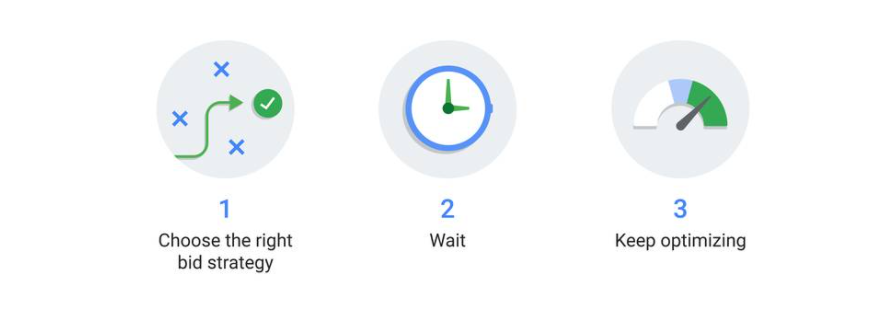
Main types of bidding strategies
Automated bidding is a trade-off between efficiency and control. Automated bidding saves time and leverages Google’s technology and proprietary data to optimize campaigns towards your goals. On the other hand, with manual bidding, you maintain full control of your bids and you are able to customize them within the same campaign. For example, you can customize bids for individual search keywords or products in Shopping. You can also use bid adjustments for Location, Day & Hour, Device and Audience.
Once you know what your Google ads goals are, you can choose from 3 basic ways to bid for your ads.
Below we’ll briefly describe all those options so you can decide which bidding strategy would be the best bidding strategy for google ads for your business.
Manual bidding strategy
Using this type of bidding, you adjust all your bids manually at any level you want: campaign, keyword or adgroup level. You just tell Google the maximum amount you’re willing to bid in an auction for your keywords. You make all decisions and take action on your Google Ads account without any smart solutions.
You can choose to place a single bid at ad group level for all keywords in that ad group, or you can split your bids keyword by keyword. But if you’ve already decided to go for manual bidding, we recommend the second option. Then you can really think it through and differentiate your bids in your favor.
The process of manual bidding requires a lot of patience, time and PPC knowledge to achieve a good ROI in the end. You need to rely on your experience and analysis of past keyword performance data.
Manual bidding might be for you if:
- Your advertising budget is limited.
- You don’t have much historical data on your Google Ads account, e.g. from a month.
- You want to have control over your Google Ads campaigns, and be able to implement quick changes.
- You can spend lots of time monitoring and improving your campaigns.
- You are new to Google Ads and want to try manual bidding before you learn how more advanced solutions work.
Advantages of manual Bidding
- You’re in control
Possibility of bidding at the keyword level - you can get more or less aggressive to win bids on the specific terms. - Quick implementation of changes
In contrast to automated bidding, any changes you make with manual bidding will be implemented immediately. - Immediate reaction
When you notice a sudden decrease in your ads’ performance, you can immediately change your keyword bids, for example reduce the bids on the low performers.
Disadvantages of manual Bidding
- Real challenge when advertising at scale
With time your PPC account might grow. Manual bidding on many different campaigns, ad groups or keywords can become a big challenge. It may need more than just one person to tackle it. - In danger of errors
With manual bidding there’s no smart solution that analyzes and makes decisions for you. PPC managers are human beings and make mistakes from time to time. - Takes lots of your time
Manual bidding is actually a full-time job. Consider whether it is worth your time.

Automated bidding strategies
Google’s Ads automated bidding strategies put Google in control of your bidding as opposed to manual bidding. Google can automate for the following:
- Position on the SERP
- Clicks
- Conversions
- Conversion value (Revenue)
- Views
- Impressions
- Email Openings
Automated bidding is designed to maximize results by automatically setting a bid based on the likelihood that your ad will receive a click or a conversion.
The system establishes this likelihood and decides on the bid by using Google’s machine learning to analyze users' data such as device, operating system, browser, previous search history, the time of day they are searching, location, and demographic data such as gender and age, as well as past data from the campaigns.
The main purpose of automated bidding is to solve the two issues that advertisers mostly have to face:
- Whether their bids are high enough to compete with qualified buyers.
- Whether their bids are too high and they're likely to be shown to people who have no interest in buying.
Automated bidding might be for you if:
- You manage big or multiple PPC accounts.
- You have a lot of historical data on your Google Ads account.
- You want to spend much time on campaign monitoring.
- You have specific campaign goals.
- You’re not experienced in running Google Ads campaigns and bidding.
In short, automated bidding is perfect for you if you have quite a big advertising budget but not too much time. In this case it might be worth letting Google’s AI take charge of your PPC account.
Advantages of automated bidding strategies
- Possible increase of efficiency/ more time
You gain more precious time, so you can focus on creating other strategies and taking care of other important tasks. With automation, you can easily manage hundreds of ad groups with a variety of keywords. - Matching your business goals with Google’s ready made strategy
Using automated bidding, you can choose one of Google’s strategies that works towards your goals. There are so many of them that you can easily find the right one for your business. - No need for in-depth PPC knowledge
You don't need to be an expert in PPC, and you don't need to do a lot of research to determine the perfect bids. Google does that for you. - Taking advantage of Google’s algorithms
If you invest in automated bidding, you can take advantage of Google's algorithms. They work pretty well to optimize your budget.
Disadvantages of automated bidding strategies
- Requires traffic and conversion data
To get good results with automated bidding, you need to wait until your Google Ads account already has a good traffic flow and a reasonable conversion volume. - Potential delays
When making changes to your campaigns in Google Ads, they may not be visible immediately. Typically, the platform synchronizes several times a day. If you want to see an immediate effect, you need to do a manual synchronization. - You lose control
When you choose automatic bidding, you have to trust Google and its algorithms to optimize the bids for you. You won't be able to decide on the bids and your budget allocation yourself.
Google’s automated bidding strategies have simplified the bidding process but don’t be fooled by the name, despite being automated, most of them require targets or bid capping to be set.
Smart bidding
Smart Bidding is not the same as automated bidding. Smart bidding strategies are a part of all automated bidding strategies. They use machine learning for optimizing your bids in order to maximize conversions and conversion value across your campaign or your bidding portfolio. That’s what makes them stand out from other automated bidding strategies.
Google smart bidding is a conversion-focused automated bid strategy. If you want to get assistance in increasing or decreasing the bid in order to get more conversions or conversion value, you can use enhanced CPC. If you decide to use them, you’ll need to set up conversion tracking if you want this to be efficient.
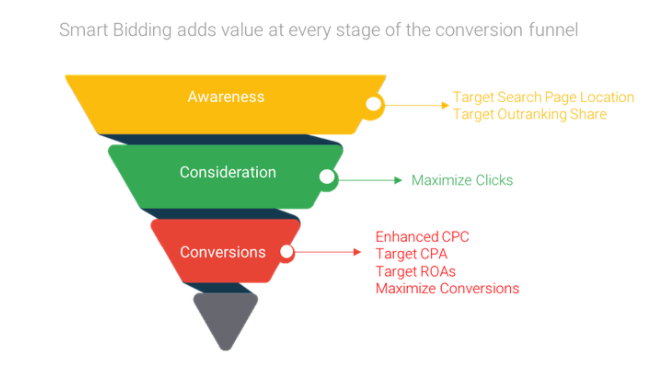
According to Google, with Smart Bidding, you get 4 key benefits that can help you save time and money and improve your campaign performance.
- Advanced machine learning
- Wide range of contextual signals
- Flexible performance controls
- Transparent performance reporting
Google ads smart bidding works for both large and small businesses and can be optimized with data from all your campaigns, so is suitable for new campaigns.
Advantages of Smart Bidding
- Saves Time
- It’s in real-time
For every auction. Every time someone types in a keyword, Google will decide the specific bid that it thinks will be most appropriate for your goal. - Leverages Google's machine learning and proprietary data
Smart bidding provides you with information (identifiable signals) about online users, which can benefit your account. The signals refer to user behavior – the time of day, day of the week, interests, previous sites visits, cross-device usage, demographics, ad characteristics and onsite behavior.
For example, Google knows the answer to this: is this particular user, with his browsing history and interests and usual behaviors etc, likely to convert for this particular advertiser? It combines it with data from the accounts conversion history. In addition, it adjusts for data that you can’t bid for, such as language, browser, operating system.
Manual bidding will allow you to adjust for device, location, weekday and time, etc. but these adjustments add up, for example, mobile +50% + Friday +20%. With Smart Bidding the system will decide what is the right bid for a mobile user on a Friday, taking into consideration all other factors also. - “Set and Forget”
Automated bidding allows you to set up a campaign and not have to monitor as often, making it easier to run for small businesses. - Accurate predictions
Google’s advanced machine learning algorithms help make accurate campaign predictions, providing a great foundation for making smart decisions.
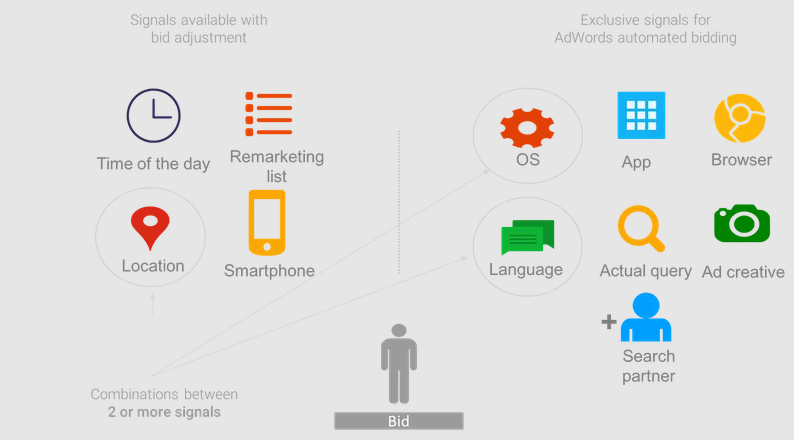
Disadvantages of Smart Bidding
- Reduced budget control
With Google Ads Performance Max campaigns, you lose control of your bids and have to trust the system with your budget. You can only set your target CPA or ROAS depending on which preferred bidding strategy you direct Google to: Maximize Conversions or Maximize Conversions Value. - You have no visibility or control over the data being used
You depend on the quality of the conversion data in addition to using Google's broad data, which may not reflect your target audience. - Google's interests are not the advertiser's interests
Google’s interest is mostly about keeping the “ecosystem” balanced and, of course, making money for itself, not making money for you as an advertiser. For example, if some of your very common keywords never convert or if you never convert on mobile, it’s still likely that you will get some traffic from Google. That's because if Google excludes its ads, or bids very low, every time there is no chance of conversion, it would risk decreasing its income. - It takes time for Google to “learn” your campaigns
Smart bidding has a learning phase when first implemented, which usually lasts about a week.. The system will tell you for how long it will take. Due to this learning phase, smart campaigns are more fragile or delicate than manual bidding.
With manual bidding, if you make a mistake you can revert it and it’s ok, but with smart bidding, if you make a mistake with a campaign or if you need to make a significant change to the campaign, e.g. a change to the budget or targeting, the campaign will go back to the learning phase. This can affect the results causing an increase in spend with poorer results or a sudden drop in spend.
What is the difference between Smart bidding and automated bidding?
Many people use Smart Bidding and automated bidding interchangeably, but they in fact refer to two different groups of bidding strategies.
The bidding strategies that fall under Google’s Smart bidding strategies are those that use “auction-time bidding”. What it means is that Smart bidding will optimize for conversion or conversion value in each and every auction.
All Smart Bidding strategies are automated.
Not all automated bidding strategies are Smart Bidding strategies.
According to Google, the main smart bidding strategies are these 4: Maximize Conversion, Maximize Conversion Value, Target CPA and. Target ROAS
Smart strategies often also include Target Impression Share and Enhanced CPC Bidding.
12 types of bidding strategies on Google Ads
Google Ads smart bidding, automated bidding, manual bidding - so many options that it's no wonder it's easy for many advertisers to get confused.
Bidding is not easy. Google Ads offers several bid strategies: both manual and automated, to give you assistance in setting bids for your ads.
These bidding strategies are tailored to different types of campaigns, depending on what the main goal with your campaign is: Getting clicks? Impressions? Conversions? Views?
1. Manual Cost-per-Click CPC
What is Manual CPC bidding?
This is a simple manual bidding strategy. You have full control over your bids but it also takes a lot of your time to monitor and adjust costs on your own.
You set bids for different ad groups or keywords without Google’s help. You can quickly adjust your budget by adding or removing money from campaigns.
Remember, that Google has the enhanced CPC check-marked by default, so you have to uncheck it in order to select the manual CPC option.
2. Enhanced CPC Bidding Strategy
What is an enhanced CPC?
The Goal of eCPC is to increase conversions while staying in control of your keyword bids.
Enhanced CPC, or eCPC, is a little different, it’s not a stand-alone bid strategy, rather it can be implemented with a manual bidding strategy when you want to take advantage of Google’s automated bidding.

With enhanced CPC for Google will automatically adjust your manual bids to help to increase your conversion rate, without increasing your cost per conversion. By selecting eCPC, you allow the system to adjust the bid at each auction, with a “guarantee” that the average cost per click will remain around the same as your selected bid.
So, let’s say you bid $15 for [running shoes], the system could bid higher on an auction with a higher possibility of conversion, and lower on auctions with a lower chance of converting, even if both searches are the same. Google uses its machine learning to adjust the bid based on the user’s data and historical conversion data to determine if the searcher is a good prospect.
When you set CPC to optimize for conversions:
- eCPC adjusts your bid for each search that your ad is relevant for, and bids based on the likelihood that a click will lead to a conversion.
- eCPC can help you get more conversions for your budget.
When you set eCPC to optimize for conversion value:
- eCPC adjusts your bid for each search that your ad is relevant for, and bids based on the likelihood that a click is to lead to a conversion. Now you can optimize bids based on conversion or based on conversion value.
Enhanced CPC Ads campaigns are the first step towards automation.
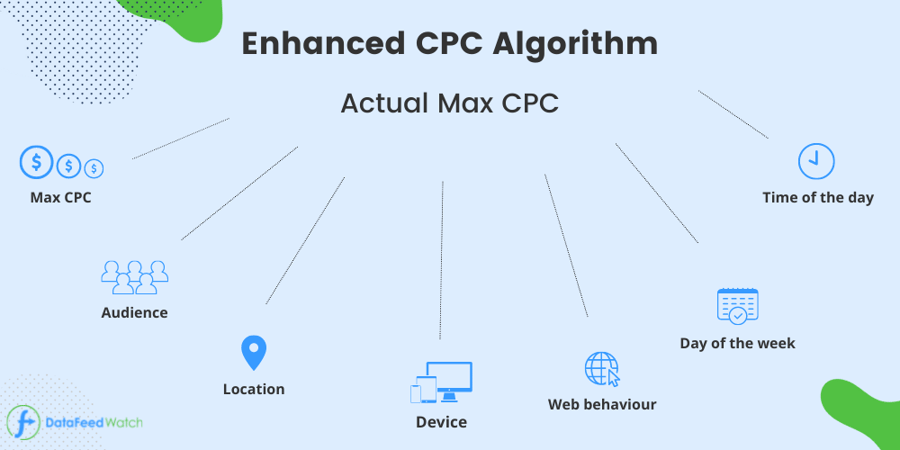
Enhanced CPC Bidding Strategy - Pros & Cons
PROs
- You can retain a lot of control - your bid is not the same in each auction, but you know that the Avg. CPC will not exceed your bid in the long run. You can still do everything you’d normally do with Manual CPC, setting specific bids for every keyword or product, targeting on Display, using bid adjustments.
- Benefit from Machine Learning - while retaining control of your campaigns, you can still take advantage of a bit of Google’s smartness and play around with it.
- Save Time - compared with manual CPC.
- Stepping stone to automated bid strategy
CONs
- It’s a compromise - Google is limited by your manual bids and bid adjustments. If your goal is conversions related, Google is pushing strongly towards more advanced automated bidding strategies to leverage advancing machine learning.
- Giving more control to Google - you need to trust in Google’s strategy.
3. Maximize Conversions
Introduced in 2021, Maximize Conversions and Maximize Conversion Value bid strategies, use Google Ads automatic Bidding to optimize for these goals.
Next Recommended Read: Understanding & Troubleshooting Google Ads Conversions
What is Maximize Conversions in Google Ads?
Maximize conversions automatically sets bids to help get the most conversions for your campaign while spending your budget. It uses advanced machine learning to automatically optimize bids and offers auction-time bidding capabilities that tailor bids for each and every auction.
Maximize Conversions is a fully automated Smart Bidding strategy. Meaning that this strategy doesn’t allow you any type of capping, limitation or targeting when it comes to bidding. It aims to bring you the most conversions for your budget. Maximize strategies aim to use the full spending budget.
According to Google this works by implementing historical information about your campaign and assessing the additional information present at the time of the auction. Maximize conversion value bidding automatically finds the best CPC bid for your ad in each auction.
While Google doesn’t actually require or suggest waiting for a number of historical conversions to be recorded before switching to this Ads automated bidding strategy, many experts advise assessing the budget spending and collecting some conversion data before implementing a maximizing conversion strategy.
Maximize Conversions - Pros & Cons
PROs
- It’s very simple to set up,
- It leverages the full smart bidding machine learning.
- Generate more conversions without exceeding your budget - it’s a great choice for campaigns already limited by budget and consistently spending the daily budget.
CONs
- It will spend the budget with no consideration for ROAS (Return On Ad Spend)
- No Control - you can end up paying a very high CPC. For example, you set a campaign targeting the keyword [running shoes fluorescent strings] with a budget of $100 and set it to Maximize Conversions to focus on sales, however, the system will think "ok, there's just a couple of searches on this, so my best chance to get the most conversions within the budget is bidding 50$ per click!”
4. Target CPA
Target CPA (tCPA) is a Smart Bidding strategy for Google Ads that uses Google advanced machine learning to automatically set the bid for each auction, with the aim to maximize the number of conversions at or below the target cost per action (CPA) you have set. It uses Google advanced machine learning to automatically set the bid for each auction.
What is Target CPA?
Target CPA is the older sister of Maximize Conversions, rolled out in 2007 with the name “Conversion optimizer” and then re-released in 2013 as Target CPA, along with Target ROAS.
What is the difference between max conversion, and Target CPA? Target CPA (tCPA) adds your desired “target” CPA into the equation.(CPA =Cost per Action, literally means Cost per Conversion... but CPC was already taken by Cost per Click).
Google will try to get you conversions at a certain CPA. You will pay per click, but the system will try to have you spending while getting conversions at your desired cost. For example, if your target CPA is $20, the system will try to have you pay for $20 in clicks before getting a conversion. As it’s just a target, it doesn’t guarantee results.
Google is not required to set a minimum number of conversions before using this bidding strategy, however, you will need to have a lot of conversion data for the system to be reliable. Google itself says "in order to evaluate it properly you should consider a period with at least 30 conversions, of a month or longer". Once you have at least 30 conversions, change the bidding strategy to Target CPA and test it. Monitor the campaign for 30 days and compare it with the last month to see if your cost/conversion is better.
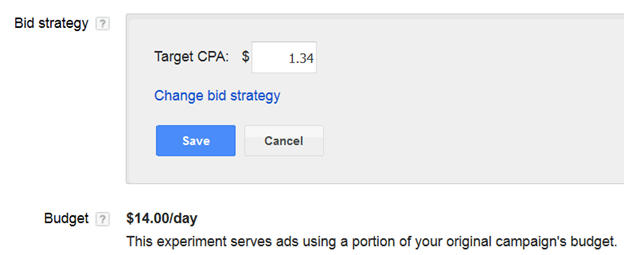
Target CPA - Pros & Cons
PROs
- It is a strategy that in some cases can allow a pay per conversion scenario
- Automates your bidding to hit CPA targets
- Good for Scaling Campaigns - It works well with an uncapped budget strategy. Meaning that the advertiser doesn’t mind how much is spent as long as the conversions
CONs
- Requires good historical data - to effectively use the target CPA strategy. As we were saying, at least 30 conversions per month to "evaluate properly". Since you input your Target CPA manually, there's a big risk that you'll input an unrealistic goal... if you do, the system will most often end up "giving up" and the campaign can even stop serving altogether, or perform erratically.
- It's a very delicate strategy - if you make drastic changes to the campaign or the target CPA itself, performances can be affected greatly.
5. Maximize Conversion Value
Using Google Ads automated bidding strategy to maximize the total conversion value of your campaigns for your specific budget.
What is Maximize Conversion Value?
Launched together with Smart Shopping Campaigns in 2018, this revolutionary type of campaign was running on a new and unique bidding strategy. In 2019 Max Conversion Value was also released for search campaigns.
The bid strategy focuses on conversion value, meaning, Google’s machine learning system factors is another important variable, conversion value. Now the system is not only looking at how likely the click is to bring conversion, as with Max Conversions, but also the likely value that the conversion is likely to have.
This automatic bidding strategy is therefore crucial to e-commerce. In standard shopping campaigns, max conversions and tCPA are not available, while on Smart Shopping (new Performance Max) campaigns, only the conversion value focussed bidding strategies, Max conversion value and tROAS, are available.
This doesn’t mean that the max conversion strategy is only used by e-commerce or businesses with online transactions, such as hospitality. The strategy can also be used in other types of business, for example, if you have a website with two goals, such as contact form completed and case study download, they are both conversions, but they have different values. Assuming the contact form submission is a lot more valuable, if you use max conversion or tCPA bidding, they will see these conversions equally.
However, if you assign a different value to your conversion, say $100 for a form complete and $15 for a case study download, you can use the max conversion value smart bidding to incorporate this data and the system will give weight to the more valuable conversions, which should result in more contact form submissions.
Max Conv Value - Pros & Cons
PROs
- It’s very simple to set up,
- It leverages the full smart bidding machine learning,
- Generate more conversion value without exceeding your budget - it’s a great choice for campaigns already limited by budget and consistently spending the daily budget,
- Increase value of conversions
CONs
- It will spend the budget with no consideration for ROAS (Return On Ad Spend)
- No Control - you can end up paying a very high CPC. For example, you set a campaign targeting the keyword [running shoes fluorescent strings] with a budget of $100 and set it to Maximize Conversions to focus on sales, however, the system will think "ok, there's just a couple of searches on this, so my best chance to get the most conversions within the budget is bidding 50$ per click!”
- Requires a lot of data to work efficiently - since it takes into account value data beyond just conversion data, this bid strategies need even more data than its counterparts to work efficiently.
6. Target ROAS
Launched in 2013, Target ROAS (tROAS) is similar to Target CPA (tCPA), except it is not just on conversions but the conversion value.
What is Target ROAS?
ROAS stands for return on ad spend—a marketing metric that measures the amount of revenue your business earns for each dollar it spends on advertising.
Essentially, ROAS is advertisings equivalent of the common business metric, Return on Investment, ROI. The higher your campaigns ROAS the more effective your campaign is.
ROAS is calculated by dividing conversion value by cost. This can either be expressed as a number or multiplied by 100 to be expressed as a percentage. For example, if your Revenue is 500 and your ad spend is 100, your ROAS is 5, 5x or 500%, however, you prefer to express it. In Google Ads, the target ROAS as a strategy is expressed as a percentage, but in the metrics columns you have “Cost Value/Cost”, which is essentially the same as ROAS, and here it’s expressed as a number.
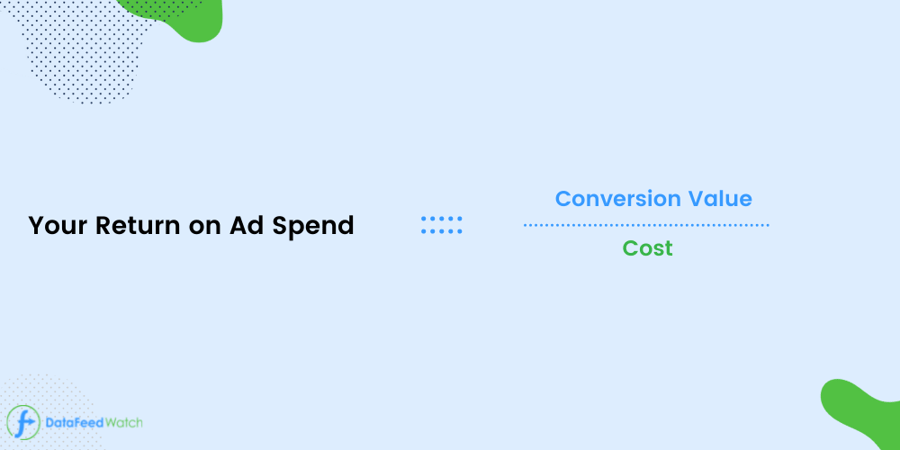
As a strategy, tROAS says to Google “please bring me x$ for every $ I spend” (as opposed to tCPA which says to Google “please bring me 1 conversion for every x$ spent). Of course, your target ROAS needs to be realistic and could be eventually raised, but only gradually and by 10-15% max to avoid volatile performance or going back to the Learning Phase.
tROAS requires a lot of data to perform effectively, even more than tCPA, to allow the results to be calculated accurately. tROAS should have at least 50 conversions in the last month before considering this strategy. Google needs to be able to calculate not only the likelihood of conversion but also the likely conversion value.
Target ROAS - Pros & Cons
The Pros & Cons for tROAS are the same as those for tCPA.
This strategy is particularly useful for Conversion Value focused advertisers, where the campaign is receiving more than 50 conversions per month and has been running for a few months at least.
7. Maximize Clicks
Maximize clicks is another automated bidding strategy that utilizes Google’s machine learning to automatically set your bids, this time to help get as many clicks as possible for your budget. It’s the easiest way to increase clicks, you set the budget and the system does the rest.
What is Maximize Clicks in Google Ads?
Similar to the Maximize strategies above, this strategy is “trying to bring you the most X while spending your budget", this time X is clicks. It has been around for a while now and is available in Standard Shopping, Search and Standard Display. Maximize Clicks was previously referred to as “Automatic bidding”.
Maximize Clicks is not a real-time auction bid strategy, instead, Google is setting a static bid on your behalf, by looking at your budget, potential auctions available and competition level.
The system is able to update your bid every time the landscape changes, (i.e. weekly). The actual bis selection is not visible to the advertiser, nor are any changes that occur. The system sets the same bid across all keywords, products, display targeting, that will aim to get you the most clicks for your budget.
The automated maximize clicks still support all the bid adjustments, which are applied to the static bid chosen by the system in the same way they would be applied to a manual bid strategy.
When using this strategy you are able to set a cap on bids allowing you to control the maximum amount you spend for each click. If you don’t set a max CPC, Google will automatically adjust our bids to get as many clicks as possible, spending all your budget.
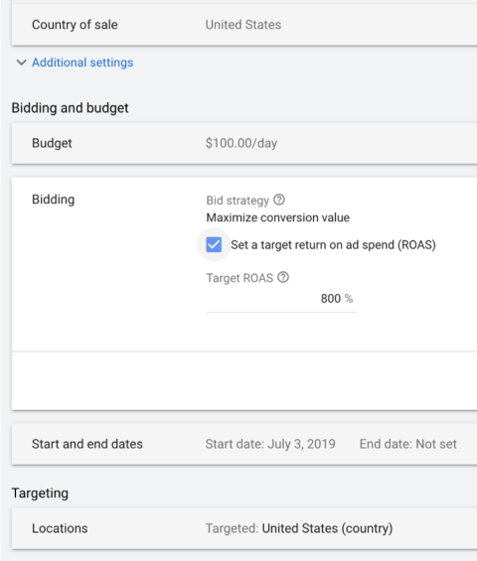
Maximize Clicks in Google Ads - Pros & Cons
PROs
- Effective for campaigns limited by budget - Max clicks tends to be the strategy with the lowest CPC, therefore it’s very good if you don’t want to start with Smart Bidding yet, but are not sure which bids to choose manually, if you want to save time, or you don’t want to focus on particular keywords or products.
- Can work with manual CPC bidding to ensure budgets are spent
- The most effective way to drive traffic to your website
CONs
- No control over traffic quality
- Less meaningful results - the system will set the same bid for every KW (search), Product (shopping), Targeting method (display), and it doesn’t differentiate, therefore if you have more expensive KWs/products, it will prioritize the cheaper auction, however, these may be the less effective for conversions. The goal is clicks, the quality of those clicks is not considered.
Maximize clicks is, for most, a "temporary" bid strategy, especially if your ultimate goal is not just traffic but conversions.
8. Target Impression Share
This strategy is only available to Seah campaigns, the goal is not clicks or conversions, but a certain occupation of the SERP, therefore targeting position and visibility.
What is Target Impression Share?
Introduced in 2018, it replaced Target Search Page Location and Target Outranking Share. As a reminder, impression share = impressions / total eligible impressions.
Google looks at the ad auctions over the day and uses internal data, such as quality, of your ads and those of other advertisers, in the same ad auctions.
Target Impressions Share is a real-time bidding strategy, where the system will set a bid for you in every action. The system sets a bit based on 3 inputs you are asked to provide.
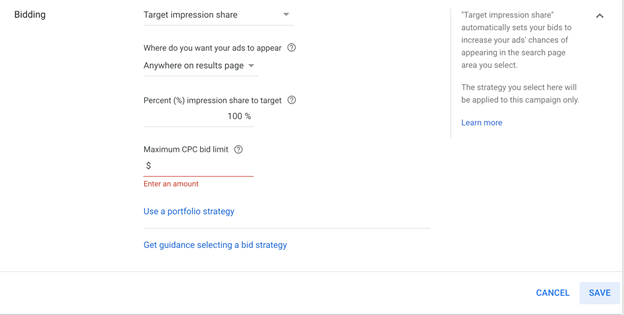
- Your goal position - Anywhere on the SERP, Top of the SERP = above organic , Absolute Top of the SERP = first position.
- How often you would like to hit our position goal - how many times, in %, you want to hit your goal position. Essentially, what is your Target Impression Share for your goal positions. For example, imagine 100 people searching for your KWs, and you get 80 impressions out of the 100 searches, 60 were at the top of the page, 20 were in the 1st positions, you would get 80% impression share, 60% Top Impression Share and 20% Abs. Top Impression Share
- Max Bid cap - you have to state a Max Bid Cap as it’s mandatory here. Without this, if you wanted to be 1st 100% of the time, which is way too optimistic, you could end up paying ridiculously high CPC without realizing what you were doing. On the other hand, if you have ambitious positioning goals but you set a low max bid cap (and too low a budget) your target will be unobtainable.
Target Impression Share - Pros & Cons
PROs
- Works well for campaigns requiring a high impression share, i.e. a Brand campaign
- Helps mobile-oriented campaigns secure ideal placements (#1 spot)
- The only automated strategy that helps to secure the top spots on Google’s SERP.
It can be great for advertisers not interested in immediate returns (traffic, CPA, ROAS) but more interested in strategic occupation of the SERP, without the need for manual bid adjustments.
CONs
- No focus on clicks or conversions if your goal is to get direct returns from your ads, and be cost-effective, this is not the right strategy for you. Occupying a certain position at all costs can lead to higher Cost Per Click (CPC). The system also doesn’t take into consideration the likelihood of a conversion, resulting in poor traffic.
9. Cost Per Thousand Impressions (CPM bidding)
What is CPM bidding?
This bidding strategy was originally created for display campaigns. Now you can also use it for Youtube campaigns. CPM bidding is solely based on impressions.
It doesn't matter if viewers actually saw the ad or skipped it, you get charged for having your ad shown. There is a specified target CPM in this tactic and you choose the average bid you’re willing to pay for every 1,000 impressions of your ad. You can consider this strategy as a manual one.
CPM bidding - Pros & Cons
PROs
- It increases your brand awareness
CONs
- You’re potentially wasting a lot of your budget on people who skip your ads.
10. Cost Per Thousand Viewable Impressions (vCPM bidding)
What is vCPM bidding?
Cost Per Thousand Viewable Impressions strategy is only available for display and Youtube campaigns. It is also a manual bidding strategy. You can set your desired bids for every 1,000 impressions where your ad was viewed by a user.
In contrast to CPM bidding, you don't waste your money on impressions of the ads that weren’t actually seen. It counts as an impression after 1 second of an ad is shown on the display Network (2 seconds on Youtube).
vCPM bidding - Pros & Cons
PROs
- Great for brand awareness campaigns
- You can predict how much you’ll spend
- You get charged only for ads that have been viewed
CONs
- ROI on this strategy can be low if your website has low traffic
- I doesn’t drive actual results, meaning conversions
11. Cost-Per-View (CPV bidding)
What is Cost Per View bidding?
This bidding strategy is dedicated to advertising videos on Google Ads. You can make use of it on the YouTube Ads platform.
You get charged either for video views or interactions, such as call to action clicks, overlay clicks, cards or companion banners.
You set the bids manually - you tell Google what’s the highest bid you’re willing to pay for a video view or an interaction. It counts as a view after 30 seconds of the video is watched (or the whole video id the ad is shorter). You pay also for every interaction with your ad even if it wasn’t watched.
Cost Per View bidding - Pros & Cons
PROs
- Perfect choice if you want to drive actual views on your ads. You don’t waste your budget on those who don’t watch your ads.
- CPV strategy Increases brand awareness.
- Usually quite cheap - below $1.
CONs
- More views is not alway equal to more conversions.
- It might be difficult to get Youtube users to watch the full 30 second of your ad.
12. Portfolio bid strategies
What are portfolio bid strategies?
After you’ve gotten familiar with all 11 strategies above, you can consider trying a portfolio bid strategy out.
This is a kind of strategy when you don’t apply different strategies at a campaign-level. Instead, you create one bidding strategy that works across multiple campaigns. You store your portfolio bid strategies in your shared library.
Among your portfolio bid strategies you can choose from:
- target CPA
- maximize conversions
- maximize conversion value
- target ROAS
- target impression share.
Portfolio bid strategies - Pros & Cons
PROs
- Some strategies usually do not allow you to set a maximum CPC. However, you can set it when you use some strategies, such as target CPA as a portfolio bidding strategy.
- The learning speed of portfolio bid strategies is faster than that of regular strategies.
CONs
- Your campaigns must have similar target CPA goals in order for you to be able to use portfolio bidding.
- The performance of your campaign in portfolio bid campaigns can be unbalanced. Google often favors some campaigns over others.

Bidding on Google ads - best practices
What we want to achieve with our bidding is to make more profit and pay less.
When implementing a bidding strategy, you need to find a balance between conversion volume and CPC.
If you keep lowering your bids, your conversion volume may decrease.
If you keep increasing bids, your conversion volume will increase, and so will your cost per conversion. You can burn through your Google Ads budget pretty quickly.
We want to share with you some bidding strategy best practices, so you can avoid these scenarios.
- Your conversion tracking always must be correct and audited.
- The same with your attribution model. Double check if it’s appropriate for your campaign goals and make sure it’s audited.
- Consider your goals and choose a bidding strategy that aims to meet your business needs.
- We recommend that you A/B test your bidding strategies before deciding which one is the right one for your business.
- Wait until there is enough data in your Google Ads account to make the right decision on bid adjustments.
- Keep track of the performance results of your ads. Do not hesitate to adjust your campaign based on what you’ve discovered.
Manual bidding vs. automated bidding strategy?
If you have a lot of time, PPC experience and like to have full control or simply don't have enough past performance data in your Google Ads account - you should probably go for manual bidding. Then you will be able to customize your bids to your needs.
If not, automated bidding strategies are perfect for filling the gaps you may have as in experience or time. More often than not, it’s just not possible to compete with the system’s machine learning, even if you are an expert, due to its computing capabilities and also its access to Google's proprietary data in real auction time.
The important thing to remember is that you do not just have to pick one automated bid strategy for your whole account, but you can pick and choose which ones to use for which campaigns. Your strategy can be set either at the ad group, campaign, or portfolio level, depending on the strategy you choose.
When choosing your strategy, it’s essential to bear in mind your goals and if you have enough data to make your chosen strategy work.
Each of the strategies mentioned above can be used, as long as it’s the right fit for your account and what you are looking to achieve. It’s important to evaluate your account regularly in order to identify which bid strategy could be useful, for example, are you now receiving conversions to implement a tCPA or tROAS campaign, that you may not have had previously.
Once you have implemented a Smart Bidding strategy, check it regularly to ensure that it’s the right strategy and it achieves the goals you set out to meet.
In addition to implementing the right bidding strategy, our Google Shopping management service can also help to maximize your results by automating your product feed, to find out more about optimizing your data feeds, read 4 Reasons Why You Should Optimize Your Data Feed or Contact Us.
